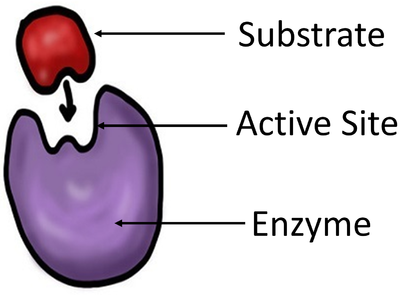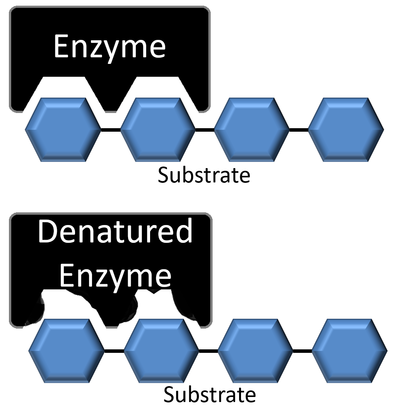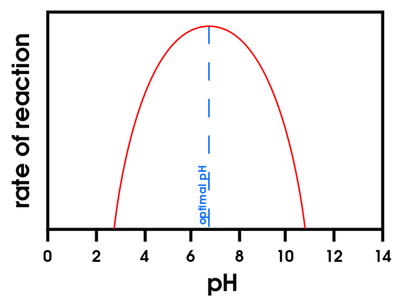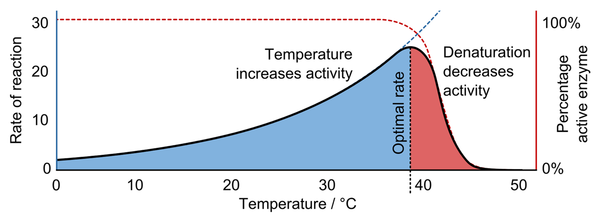Difference between revisions of "Enzyme"
| Line 8: | Line 8: | ||
: The [[chemical]]s that an [[enzyme]] affects are called [[Substrate (Biology)|substrates]]. | : The [[chemical]]s that an [[enzyme]] affects are called [[Substrate (Biology)|substrates]]. | ||
: [[Enzyme]]s have an area called an [[Active Site|active site]] which is where the [[enzyme]] interacts with the [[substrate]]. | : [[Enzyme]]s have an area called an [[Active Site|active site]] which is where the [[enzyme]] interacts with the [[substrate]]. | ||
| + | : The [[Active Site|active site]] is shaped to fit with only one [[Substrate (Biology)|substrate]] so [[enzyme]]s all have specific roles in an [[organism]]. | ||
| + | |||
{| class="wikitable" | {| class="wikitable" | ||
|- | |- | ||
| Line 17: | Line 19: | ||
===Denaturation=== | ===Denaturation=== | ||
: [[Enzyme]]s can be [[denature]]d if the [[temperature]]s are too high or the [[pH]] is too extreme. Different [[enzyme]]s have a different [[Optimum|optimum]] [[temperature]] and [[Optimum|optimum]] [[pH]]. | : [[Enzyme]]s can be [[denature]]d if the [[temperature]]s are too high or the [[pH]] is too extreme. Different [[enzyme]]s have a different [[Optimum|optimum]] [[temperature]] and [[Optimum|optimum]] [[pH]]. | ||
| − | + | : When an [[enzyme]] is [[denature]]d it changes shape so that the [[substrate]] will no longer fit the [[Active Site|active site]]. | |
| + | {| class="wikitable" | ||
| + | |- | ||
| + | |[[File:DenaturedEnzyme.png|center|400px]] | ||
| + | |- | ||
| + | | style="height:20px; width:200px; text-align:center;" |This [[diagram]] shows an [[enzyme]], [[Substrate (Biology)|substrate]] and the [[Active Site|active site]] of the [[enzyme]]. | ||
| + | |} | ||
===pH and Enzymes=== | ===pH and Enzymes=== | ||
: [[Enzyme]]s have an [[optimum]] [[pH]] at which they work best. If the [[pH]] is far from this [[optimum]] value the [[enzyme]] will [[denature]]. | : [[Enzyme]]s have an [[optimum]] [[pH]] at which they work best. If the [[pH]] is far from this [[optimum]] value the [[enzyme]] will [[denature]]. | ||
Revision as of 12:00, 5 November 2018
Contents
Key Stage 4
Meaning
Enzymes are large proteins that can act as a catalyst for chemical reactions or be used to break down large molecules into smaller ones.
About Enzymes
- Organisms have a number of different enzymes that control the chemical reactions that take place inside the cytoplasm.
- Digestive enzymes are used to break down large insoluble food molecules into small soluble molecules.
- The chemicals that an enzyme affects are called substrates.
- Enzymes have an area called an active site which is where the enzyme interacts with the substrate.
- The active site is shaped to fit with only one substrate so enzymes all have specific roles in an organism.
| This diagram shows an enzyme, substrate and the active site of the enzyme. |
Denaturation
- Enzymes can be denatured if the temperatures are too high or the pH is too extreme. Different enzymes have a different optimum temperature and optimum pH.
- When an enzyme is denatured it changes shape so that the substrate will no longer fit the active site.
| This diagram shows an enzyme, substrate and the active site of the enzyme. |
pH and Enzymes
- Enzymes have an optimum pH at which they work best. If the pH is far from this optimum value the enzyme will denature.
| This graph shows the optimum pH for amylase. |
Temperature and Enzymes
- Enzymes have an optimum temperature at which they work best. If the temperature is far above this optimum value the enzyme will denature. If the temperature is far lower the rate of reaction slows down due to the number of particle collisions being lower at lower temperatures.
| This graph shows the optimum temperature for many enzymes in the human body. |
- If the temperature goes above 45 all of the enzymes will be denatured.



